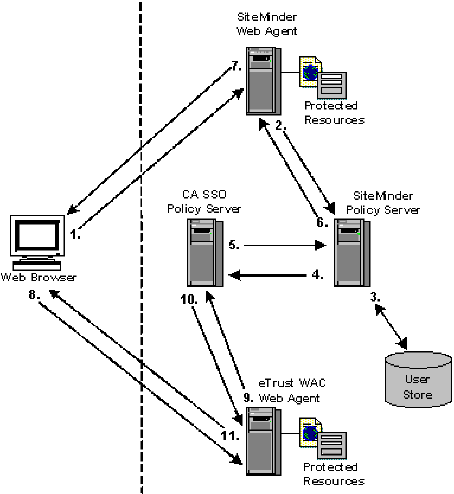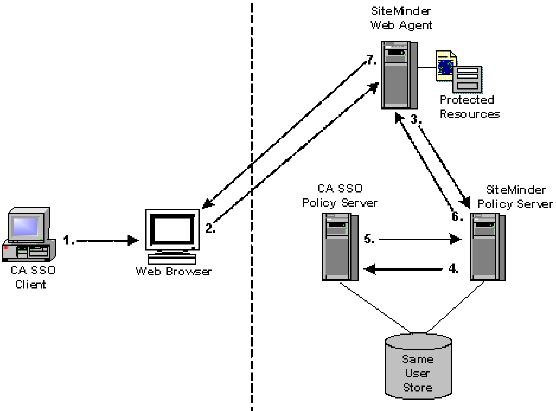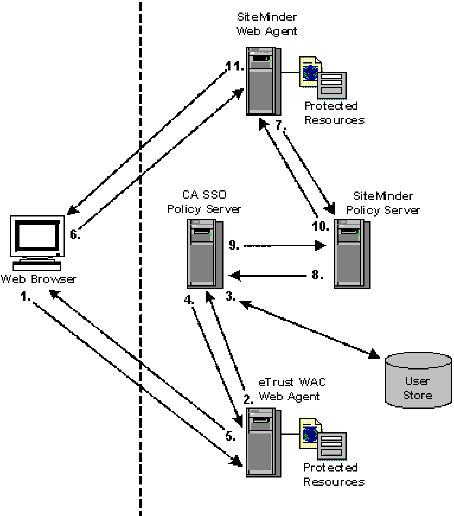

Policy Server Guides › Policy Server Configuration Guide › CA SSO/WAC Integration › SiteMinder and CA SSO Integration Architectural Examples
SiteMinder and CA SSO Integration Architectural Examples
The following examples demonstrate single sign-on between CA SiteMinder® and CA SSO environments:
- A user authenticates to CA SiteMinder® using a Web browser and then accesses an CA SSO-protected resource (see Example 1: User Accesses SiteMinder-Protected Resource Before CA SSO).
- A user authenticates to CA SSO through a desktop CA SSO Client and then accesses a CA SiteMinder®-protected resource using a Web browser (see Example 2: Authenticated CA SSO Client User Accesses SiteMinder Resource).
- A user authenticates to CA SSO using a Web browser and then accesses a CA SiteMinder®-protected resources (see Example 3: User Accesses CA WAC-Protected Resource Before SiteMinder).
More information:
Configure Single Sign-On from CA SSO Client to SiteMinder
User Accesses SiteMinder-Protected Resource Before CA SSO
The following example illustrates a user accessing CA SiteMinder®-protected resource before a WAC-protected resource:

- The user tries to access a CA SiteMinder®-protected resource and the CA SiteMinder® Web Agent/CA SiteMinder® SPS intercepts the request. The user provides the Agent/SPS with authentication credentials.
- The Web Agent/CA SiteMinder® SPS forwards the credentials to the Policy Server for validation.
- The Policy Server verifies that the credentials of the user are valid.
- After successful authentication, the Policy Server requests the CA SSO Policy Server to issue and return a CA SSO cookie for the user.
- The CA SSO Policy Server validates the user and forwards the CA SSO web authentication credentials of the user to the Policy Server.
- The CA SiteMinder® Policy Server forwards the CA SSO web authentication credentials to the CA SiteMinder® Web Agent/CA SiteMinder® SPS.
- The CA SiteMinder® Web Agent/CA SiteMinder® SPS sets the CA SSO web authentication and CA SiteMinder® cookies in the browser of the user. The resource appears to the user.
- The user tries to access a CA SSO resource and the eTrust WAC Web Agent intercepts the request.
- The eTrust WAC Web Agent validates the CA SSO web authentication cookie credentials of the user with the CA SSO Policy Server.
- The CA SSO Policy Server tells the eTrust WAC Web Agent that the user has valid credentials.
- The eTrust WAC Web Agent allows the user to access the CA SSO-protected resource.
Authenticated CA SSO Client User Accesses SiteMinder Resource
The following example illustrates an authenticated CA SSO client user accessing a CA SiteMinder® protected resource:

- An authenticated CA SSO Client user launches a Web browser. While this is happening, the CA SSO Client places an CA SSO Web authentication cookie into the browser.
- The user tries to access a CA SiteMinder®-protected resource using the Web browser and the request is intercepted by the CA SiteMinder® Web Agent/CA SiteMinder® SPS.
- The CA SiteMinder® Web Agent/CA SiteMinder® SPS forwards the CA SSO Web authentication cookie to the CA SiteMinder® Policy Server.
- The CA SiteMinder® Policy Server forwards the CA SSO Web authentication cookie to the CA SSO Policy Server.
- The CA SSO Policy Server validates the CA SSO Web authentication cookie and returns the user name to the CA SiteMinder® Policy Server.
- The CA SiteMinder® Policy Server verifies the returned user name in the CA SiteMinder® user store, then issues a corresponding CA SiteMinder® cookie and returns it to the CA SiteMinder® Web Agent/CA SiteMinder® SPS.
- The CA SiteMinder® Web Agent/CA SiteMinder® SPS returns the requested resource to the user, who now has the authentication cookie credentials necessary for CA SiteMinder® and CA SSO environments.
User Accesses eTrust WAC-Protected Resource Before SiteMinder
The following example illustrates a user accessing a WAC-protected resource before the product.
Note: The example assumes that the environment is using an IIS6 WAC Agent. An IIS6 WAC Agent is the only platform that the following example supports.

- The user tries to access a CA SSO-protected resource and the eTrust WAC Web Agent intercepts the request. The user provides the Agent with authentication credentials.
- The agent forwards the credentials to the CA SSO Policy Server for validation.
- The CA SSO Policy Server verifies that the credentials of the user are valid.
- The CA SSO Policy Server forwards the eTrust SSO web credentials of the user to the eTrust WAC web agent.
- The eTrust WAC web agent sets the CA SSO web authentication cookie in the web browser of the user.
- The user tries to access a protected resource and the web agent/CA SiteMinder® SPS intercepts the request.
- The web agent/CA SiteMinder® SPS forwards the CA SSO web authentication credentials of the user to the Policy Server.
- The Policy Server forwards the CA SSO web authentication credentials of the user to the eTrust SSO Policy Server.
- The CA SSO Policy Server validates the CA SSO web authentication credentials of the user. Then the CA SSO Policy Server forwards the user name back to the Policy Server.
- The Policy Server verifies the returned user name in the user store, then issues a corresponding cookie and returns it to the agent/CA SiteMinder® SPS.
- The Web Agent/CA SiteMinder® SPS sets the cookies in the browser of the user. This process allows the user to access the requested resource.
Copyright © 2015 CA Technologies.
All rights reserved.
 
|
|




